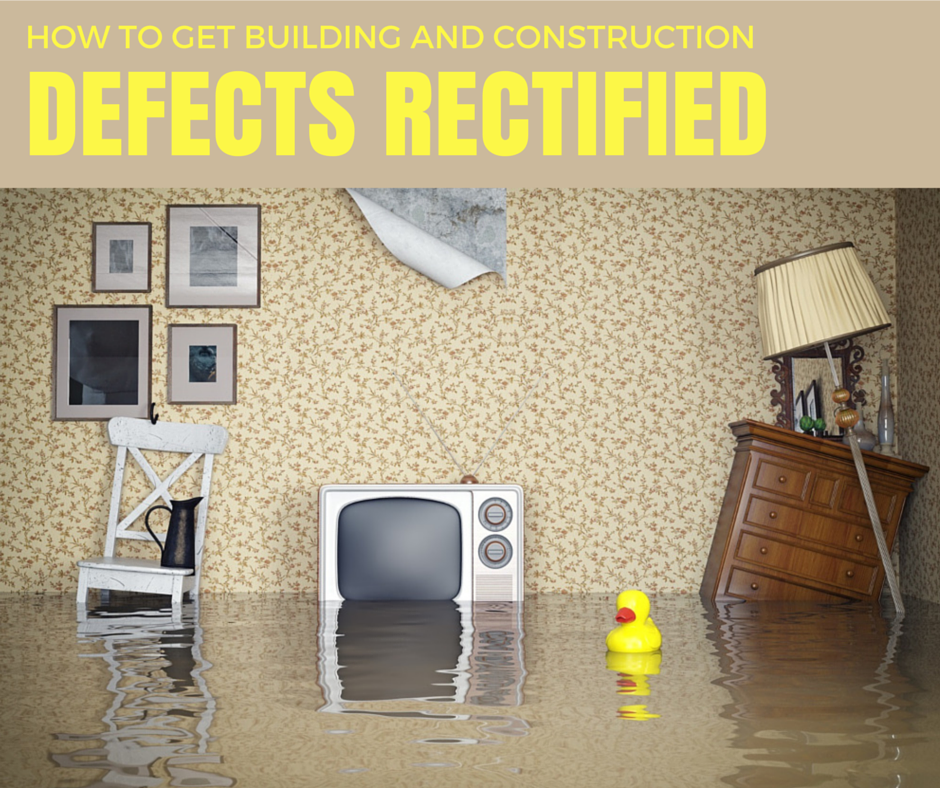I had this email recently: Altered slightly to preserve anonymity.
Our building is 8 years old. From day 1 we have pretty well had problems with a leaking roof. Each time we called the builder to rectify they have come and done a patch up job.
With the heavy rains, this has been an ongoing issue. My understanding is the cause has been the box guttering and the design of the building and roof.
We have recently received a quote to repair and completely rectify and the cost will exceed $4,500 dollars each!
Whilst I accept that there will always be ongoing maintenance I do not accept that a building that is only 8 years old needs such major works to rectify this issue and that we have to ‘wear it on the chin’.
I would like to know if you have come across this before and what avenues we have, if any?
What’s being described here is a building and construction defect. And yes it is very common.
A recent study found a whopping 82% of buildings built after 2000 have reported building defects of some sort. And of those who have reported, 85% of them further report the issue has never been rectified comprehensively.
In the searches I’ve done over the last few months I’ve seen:
- A ten year old building with significant defects estimated at $3 million to rectify
- A 12 story building with a basement that is unsound
- A three year old building with in excess 1,000 defects one of which will require a roof replacement
All of these buildings have issues that stem from either the design of the building or the construction phase.
Design Issues
It used to be that what set a building development aside was its amazing location. Now there are a lot of existing buildings to choose from, and a lot of them in similar or even the same location.
The pressure is on developers to come up with something different and / or extraordinary to attract buyers to their offerings. Which they do.
For instance, I saw this amazing concept for a rotating apartment building this week. The whole building revolves so every apartment gets to enjoy a slice of the 360 degree view over time.
As a concept? Nifty.
As an actuality? Call me a Negative Nelly but I foresee that actually turning that concept into a functional building that delivers what’s promised would be difficult to achieve.
That’s the significant problem with design. If new concepts are used in the design they may or may not be a fantastic innovation. Unfortunately which it is isn’t clear until the building is built and it does or doesn’t work.
It’s a significant problem when it just doesn’t work.
Construction issues
One of the issues with addressing building and construction defects is working out whether the problem stems from design or construction.
Construction defects happen, in every structure that gets built or renovated, which is why building contracts include such stringent clauses around rectification.
And it’s easy to see why. Even just building a house there are hundreds of thousands of individual tasks that must be completed. It is simple for something to be overlooked or just done wrong.
The bigger the building the more tasks to be completed and the higher the risk that something, or a lot of things, are not done correctly.
Don’t forget to factor in materials. Sun City Resort is a Gold Coast high rise that experienced significant defects in the window frames installed. They had to be replaced at a cost of millions. Who was responsible sparked a legal battle between the body corporate, developer, builder and window frame manufacturer.
What happens if there are building and construction defects?
The building contract will set out rectification processes for building and construction defects.
Beyond the contracted remedies the builder must also warrant the building.
In Queensland the warranties applying will depend on the type of defects. There are two types of defect;
- Category 1 or structural defects
- Category 2 or cosmetic defects
Different warranty periods apply to different categories.
For category 2 defects there is six months from practical completion to rectify defects. One of the first things the newly established body corporate should do is report any cosmetic defects.
For category 1 defects there is 6 ½ year warranty period. To be rectified issues must be reported in that time.
What a lot of body corporates do, particularly larger schemes, is engage an Structural Engineer to inspect the building sometime in the first year or two and produce a report.
That report is submitted to the builder who then, hopefully, comes and rectifies the issue.
A second report is then prepared before the expiration of the warranty period to ensure the previously identified defects have actually been addressed, and to add any new defects that may have manifested.
What if the issue is not rectified?
In this particular case the builder has been notified of the issue, which they have come and addressed. On a number of occasions.
Unfortunately the repair didn’t resolve the issue. What next?
There is a dispute resolution process for building and construction defects that needs to be followed.
In the first instance you must always try and resolve the issue directly with the builder.
If that doesn’t work then your next step is to have a discussion with the Queensland Building & Construction Commission (QBCC). They provide oversight on building contracts in QLD.
The QBCC may encourage you to make an application. Once an application is lodged an inspector will visit the site, inspect the issue and any rectification attempts. If, in their opinion, the issue is a building and construction defect they will issue an Order to the builder to rectify.
The builder should then rectify the issue.
The QBCC Order remains current until the matter is complete. Sometimes the inspector will visit the site again to verify, but in some cases it’s not practical. For instance with water leaks; there may be months, or even years, between repair and the next heavy rains which really put the remedy to the test.
It’s not uncommon for building defect cases to drag on for years.
If the builder does not rectify the issue and is in breach of the QBCC Order the matter will need to proceed to legal action.
Who is responsible for rectification?
When it comes to legal action there are many, many factors that will influence what happens and there is no guarantee that the body corporate will be successful.
The problem with rectifying building and construction defects in body corporates is the circular nature of the contractual obligations.
If you build a house, you hire a builder. There is a contract between you and the builder and it’s all pretty clear cut. The builder must produce what you’ve contracted for and you have remedies if they do not.
With strata schemes the developer contracts with the builder, who produces the product. It’s only when construction is complete that the subdivision is registered which is when the body corporate is created.
The recent land mark Brookfield case clarified this point in a NSW High Court.
The lot owners, and by extension the body corporate, are second owners.
What all this means is when you get right down to the nitty gritty of legal action the duty of care that the builder owes via the contract is not to the body corporate. It’s to the developer, effectively leaving the body corporate and lot owners out in the cold.
The Brookfied case is a NSW case and how it will affect QLD case law is uncertain.
There are certainly body corporates who are successfully pursing legal action for building defects. There are just as many who are not successful. It will come down to a question of the facts in your particular circumstances.
To find out if your body corporate has a case a conversation with a good Solicitor, preferably with body corporate experience, is your best next step.
What other options do we have?
Pursuing matters through the courts is expensive and not guaranteed to succeed.
For some body corporates in the end they simply choose to resolve the matter themselves. The get independent suggestions for rectification, something that would be required for court action as well, and then proceed to getting quotes.
Once a definitive solution is reached the body corporate simply proceeds with the works and the lot owners finance the costs.
At the end of the day it comes down to weighing the trade-offs. Legal action is expensive and there is no guarantee, however that needs to be balanced against the costs of rectification.
A lot of cases reach a settlement where the builder and / or the developer make a cash payment toward the repair works in exchange for indemnity from further legal action.
What if the warranty period has expired?
Outside of the warranty period problems in the buildings are the body corporate responsibility.
But just because the warranty period has expired doesn’t necessarily mean there is no avenue to continue with the dispute resolution process.
Buildings that are experiencing ongoing issues sometimes launch legal action prior to the expiration of the warranty period to ensure the matter is not just forgotten.
Again however that is not your only option. If you have been attempting to get a defect rectified by the builder in the warranty period, and the rectification is not successful, then you may still have legal avenues to proceed.
For instance, my correspondent. Their building warranty had expired (an eight year old building), however, when they contacted the QBCC they found that a previous Order had been made to the builder.
The builder had rectified the issue, but that also means the building warranty on the repair had also reset. They now have until 2017 to continue seeking remedies from the builder for repair of the problem.
What if there are building and construction defects in my lot?
This discussion related to common property of the body corporate. Building and construction defects in your lot are your responsibility. If you find issues in your lot it is your responsibility to raise the issues with your builder.
Do liaise with your body corporate about what they’re doing to rectify defects, and duplicate their efforts with your own complaint. Talk to other affected owners as well if you can. It’s not strictly necessary but it may help you navigate through the process.
Conclusion
Building and construction defects are to be expected in new buildings. Resolving them will require persistence and diligence on behalf of the Committee.
It is well worth going through the process because you are entitled to a product (building) free from defect and rectification can be very expensive.
Have an experience with building defects to add? Leave a comment or send me an email, I’d love to hear from you.

